An Ariane 44L rocket successfully launched an Intelsat 905 telecommunications satellite into orbit on Wednesday – liftoff was at 0644 GMT (2:44am EDT) from Kourou, French Guiana. Once in its final position, the Intelsat 905 will provide Ku-band coverage for much of North America and Western Europe. This was the seventh launch of the year for Arianespace.
No More Delays, Endeavour Launches
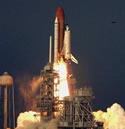
Image credit: NASA
With the weather finally on side for NASA, the space shuttle Endeavour blasted off Wednesday afternoon from Florida’s Cape Canaveral. The shuttle launched at 2122 GMT (5:22 EDT) carrying the crew of Expedition 5 into orbit, bound for the International Space Station. Endeavour will dock with the station on Friday and relieve the 3-man crew of Expedition 4. Shuttle astronauts will also perform 3 spacewalks to install some additional components onto the station.
With improved weather conditions at the Kennedy Space Center, Endeavour lifted off at 4:23 p.m. CDT today, beginning a complex mission to continue the assembly and maintenance of the International Space Station and bring a new trio of residents to the orbital outpost.
Aboard Endeavour are Commander Ken Cockrell, Pilot Paul Lockhart, Mission Specialists Franklin Chang-D?az and Philippe Perrin of the French Space Agency, CNES, along with Expedition 5 Commander Valery Korzun and Flight Engineers Peggy Whitson and Sergei Treschev. As Endeavour launched from Florida, the space station orbited 240 statute miles over the southern Indian Ocean west of Perth, Australia.
Aboard the ISS, Expedition 4 Commander Yury Onufrienko and Flight Engineers Carl Walz and Dan Bursch are wrapping up their 182nd day in space, their 180th day on the station. Walz and Bursch will break the U.S. record for the longest single space flight ? 188 days ? set by astronaut Shannon Lucid in 1996. Another record was equaled today as Chang-D?az became only the second human to fly in space seven times, tying a mark set in April by Jerry Ross on the STS-110 mission.
Less than nine minutes after launch, Endeavour and its crewmembers settled into orbit and work began to prepare the shuttle for its planned 12-day mission.
Endeavour is scheduled to dock to the station Friday afternoon, setting the stage for the handover between the Expedition 4 and Expedition 5 station crews. Three spacewalks are scheduled during the mission by Chang-D?az and Perrin. The first two will help install and activate the Mobile Base System, a platform that will be mated to the Mobile Transporter on the S-Zero (S0) Truss. The new platform will allow the station?s Canadarm2 robotic arm to ?walk off? the Destiny Laboratory onto the Mobile Base System so it can be transported up and down the length of the ISS for future assembly tasks. On the third spacewalk, Chang-D?az and Perrin will replace a faulty wrist roll joint on the station?s robotic arm that has experienced an electrical problem in one of its two data and power channels.
The shuttle crew will go to sleep at 10:23 p.m., and will be awakened at 6:23 a.m. Thursday to begin its first full day in orbit. The next STS-111 mission status report will be issued Thursday morning after Endeavour?s crew is awakened.
Original Source: NASA News Release
Is Life the Rule or the Exception?
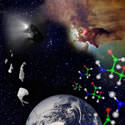
Image credit: ESA
Some scientists have theorized that life on Earth began when amino acids, the building blocks of life, were delivered from space by comets and asteroids. The European Space Agency is planning two missions to help gather more evidence. Rosetta, due for launch in 2003, will study the composition of gas and dust released from a comet to sense what kinds of organic molecules they contain, while Herschel, due for launch in 2007 will focus on the chemistry of interstellar space, searching for traces of the material in distant clouds of dust.
Is life a highly improbable event, or is it rather the inevitable consequence of a rich chemical soup available everywhere in the cosmos? Scientists have recently found new evidence that amino acids, the ‘building-blocks’ of life, can form not only in comets and asteroids, but also in the interstellar space.
This result is consistent with (although of course does not prove) the theory that the main ingredients for life came from outer space, and therefore that chemical processes leading to life are likely to have occurred elsewhere. This reinforces the interest in an already ‘hot’ research field, astrochemistry. ESA’s forthcoming missions Rosetta and Herschel will provide a wealth of new information for this topic.
Amino acids are the ‘bricks’ of the proteins, and proteins are a type of compound present in all living organisms. Amino acids have been found in meteorites that have landed on Earth, but never in space. In meteorites amino acids are generally thought to have been produced soon after the formation of the Solar System, by the action of aqueous fluids on comets and asteroids – objects whose fragments became today’s meteorites. However, new results published recently in Nature by two independent groups show evidence that amino acids can also form in space.
Between stars there are huge clouds of gas and dust, the dust consisting of tiny grains typically smaller than a millionth of a millimetre. The teams reporting the new results, led by a United States group and a European group, reproduced the physical steps leading to the formation of these grains in the interstellar clouds in their laboratories, and found that amino acids formed spontaneously in the resulting artificial grains.
The researchers started with water and a variety of simple molecules that are known to exist in the ‘real’ clouds, such as carbon monoxide, carbon dioxide, ammonia and hydrogen cyanide. Although these initial ingredients were not exactly the same in each experiment, both groups ‘cooked’ them in a similar way. In specific chambers in the laboratory they reproduced the common conditions of temperature and pressure known to exist in interstellar clouds, which is, by the way, quite different from our ‘normal’ conditions. Interstellar clouds have a temperature of 260 ?C below zero, and the pressure is also very low (almost zero). Great care was taken to exclude contamination. As a result, grains analogous to those in the clouds were formed.
The researchers illuminated the artificial grains with ultraviolet radiation, a process that typically triggers chemical reactions between molecules and that also happens naturally in the real clouds. When they analysed the chemical composition of the grains, they found that amino acids had formed. The United States team detected glycine, alanine and serine, while the European team listed up to 16 amino acids. The differences are not considered relevant since they can be attributed to differences in the initial ingredients. According to the authors, what is relevant is the demonstration that amino acids can indeed form in space, as a by-product of chemical processes that take place naturally in the interstellar clouds of gas and dust.
Max P. Bernstein from the United States team points out that the gas and dust in the interstellar clouds serve as ‘raw material’ to build stars and planetary systems such as our own. These clouds “are thousands of light years across; they are vast, ubiquitous, chemical reactors. As the materials from which all stellar systems are made pass through such clouds, amino acids should have been incorporated into all other planetary systems, and thus been available for the origin of life.”
The view of life as a common event would therefore be favoured by these results. However, many doubts remain. For example, can these results really be a clue to what happened about four billion years ago on the early Earth? Can researchers be truly confident that the conditions they recreate are those in the interstellar space?
Guillermo M. Mu?oz Caro from the European team writes “several parameters still need to be better constrained (…) before a reliable estimation on the extraterrestrial delivery of amino acids to the early Earth can be made. To this end, in situ analysis of cometary material will be performed in the near future by space probes such as Rosetta …”
The intention for ESA’s spacecraft Rosetta is to provide key data for this question. Rosetta, to be launched next year, will be the first mission ever to orbit and land on a comet, namely Comet 46P/Wirtanen. Starting in 2011, Rosetta will have two years to examine in deep detail the chemical composition of the comet.
As Rosetta’s project scientist Gerhard Schwehm has stated, “Rosetta will carry sophisticated payloads that will study the composition of the dust and gas released from the comet’s nucleus and help to answer the question: did comets bring water and organics to Earth?”
If amino acids can also form in the space amid the stars, as the new evidence suggests, research should also focus on the chemistry in the interstellar space. This is exactly one of the main goals of the astronomers preparing for ESA’s space telescope Herschel.
Herschel, with its impressive mirror of 3.5 metres in diameter (the largest of any imaging space telescope) is due to be launched in 2007. One of its strengths is that it will ‘see’ a kind of radiation that has never been detected before. This radiation is far-infrared and submillimetre light, precisely what you need to detect if you are searching for complex chemical compounds such as the organic molecules.
Original Source: ESA News Release
Bad Weather Scrubs Endeavour Launch
Stormclouds above Cape Canaveral pushed back the launch of the space shuttle Endeavour on Thursday. NASA meteorologists had been predicting bad weather all week, so the scrub came as no surprise. The launch was pushed back to Friday evening, but even that launch date is at risk, as the stormy weather is expected to last through the weekend. When Endeavour does get into space, it will deliver Expedition 5 to the International Space Station, and return the previous crew back to Earth.
Endeavour Launch Time Announced
Space shuttle managers announced the launch time for mission STS-111 on Wednesday afternoon – Endeavour will launch from Cape Canaveral on Thursday evening at 2344 GMT (7:44pm EDT). Although it was known that the launch was scheduled for Thursday, the exact time was kept secret for security reasons. Endeavour will carry the crew of Expedition 5 to the International Space Station as well as install the new Mobile Remote Servicer Base System. The weather doesn’t look good though, and could very well scrub the launch.
Solar Flare Silences Japanese Mars Probe
A solar flare has struck Nozomi, Japan’s first probe to Mars, cutting off its communications with Earth. Japanese scientists believe that the spacecraft can repair the damage within 6-months, hopefully before it arrives at the Red Planet in December 2003. The solar flare happened over a month ago, but the damage to the spacecraft was only recently admitted to the public. Nozomi will study Mars’ upper atmosphere and magnetic field.
Spotlight on the 2MASS Sky Survey
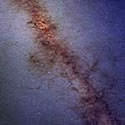
Image credit: 2MASS
One of the most groundbreaking work in astronomy being done right now is the Two Micron All-Sky Survey which is producing a high-resolution survey of the entire sky in the Infrared spectrum. Two telescopes, one in Arizona, the other in Cerro Tololo, Chile have been working non-stop for 4 years to take over 100 million individual images; these have been stitched together by computer. Infrared light has a much longer spectrum than visible light, so the images reveal objects which would normally be obscured by thick clouds of gas and dust.
Would it be possible to see the entire sky without ever stepping outside? Well, if you have access to a computer, the answer would be ?yes,? thanks to the Two Micron All-Sky Survey (2MASS), the most detailed digital map of the heavens ever made.
“These telescopes have given us the first detailed global view of our Milky Way Galaxy and the galaxies that lie beyond,” said Dr. Michael Skrutskie of the University of Virginia, the survey?s principal investigator. “The resulting databases and source catalogues are a treasure trove which will be mined for discovery by scientists and the public alike for decades to come.”
A Huge Undertaking
This tremendous task was accomplished by dividing the sky into nearly 60 thousand strips, each covering roughly the area of a toothpick held at arm?s length. Two dedicated telescopes, one in Arizona, the other in Cerro Tololo, Chile, patiently scanned these strips of sky every night, weather permitting, for nearly four years. The telescopes were built and observations conducted by the University of Massachusetts at Amherst.
While observations concluded in February 2001, the massive data reduction efforts have continued at the Infrared Processing and Analysis Center on the Caltech campus.
The 2MASS software automated what would have taken astronomers decades to do using conventional techniques. The system processed over 100 million individual frames, stitching them together into larger images while simultaneously identifying and measuring the properties of all the stars and galaxies seen within them.
An Infrared Perspective
The ?Two Micron? part of the sky survey refers to the part of the spectrum viewed by the survey?s digital eyes. Near-infrared light has a wavelength about four times longer than visible light, well beyond the limits of human vision. The survey telescopes employed sophisticated electronic cameras cooled to temperatures not far above absolute zero to see into this part of the spectrum.
The cameras simultaneously captured the sky in three different colors of infrared light. By remapping these colors into the visible colors of red, green, and blue, astronomers have produced full color images of the sky that look similar to ordinary visible light images, but show different features. Even well-known objects like the Orion Nebula take on striking new appearances.
Near-infrared light offers several advantages to astronomers. It more easily penetrates clouds of dust like those found across the Milky Way, revealing stars and galaxies that are completely hidden in visible light. It is also more sensitive to the largest population of stars in the Galaxy, the ones that are smaller and cooler than the Sun. The Two Micron All-Sky Survey observations open up the universe for studies of previously unknown stars and lay bare the internal structures of distant galaxies.
The Galaxy Inside-Out
One stunning product of the survey is an ?inside-out? view of our own Milky Way Galaxy. Constructed from the database of half a billion stars automatically identified by the processing software, it gives an unparalleled census of the Milky Way?s geography and population.
Evident in striking detail is the flat disk, punctuated by thin lanes of dense dust clouds. Towards the center we find the galactic bulge surrounding the inner nucleus of the Milky Way, long thought to harbor a supermassive black hole.
The view also extends beyond just the local Milky Way stars. Just beneath and right of the galactic center we can see the star clouds associated with our nearest neighbors: the Large and Small Magellanic clouds. A very sharp eye can even pick out a faint ?finger? of stars in the lower left side of the galactic bulge; this is the first direct image ever made of a small dwarf galaxy recently discovered to be in the process of merging with the Milky Way.
Getting the Pictures
The Two Micron All-Sky Survey has opened up new views of the universe, literally allowing people to see the whole sky in a different light. And anyone with access to a web browser can enjoy the visual feast.
The catalogues and images are distributed freely to the astronomical community and the general public via the Internet. Nearly half of the sky is currently available, and processing is ongoing for the final data release, expected in late summer 2002.
When the final sets of catalogues and images come online, they will consist of about 2 terabytes (that’s 2,000 gigabytes, or 2 million megabytes!) of computer data.
The final release will include catalogues of about half a billion stars and 2 million galaxies. Over one million research-quality images of the whole sky will be available in each of the three infrared colors observed by 2MASS. Such huge data sets represent part of astronomy’s future, as scientists learn interesting new things by analyzing terabyte-sized sets of data.
Fortunately the astronomy enthusiast has more direct access to this fantastic sky imagery. A new ?2MASS Showcase? gallery contains a selection of the very finest full color images from the survey, some at resolutions suitable for printing full posters!
In addition, the existing Image Gallery and Picture of the Week archives contain hundreds of images of interesting objects throughout the Galaxy and beyond. Even the most demanding visitors should be able to find the infrared views of their favorite objects now that the sky is online for everyone to enjoy!
Original Source: NASA News Release
Galileo’s Last Look at Io
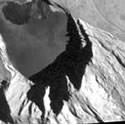
Image credit: NASA
The final images that the Galileo spacecraft will take of Jupiter’s moon Io were released today. They showcase crumbling crater slopes and the surface deposits from recent eruptions. Galileo also discovered 13 previously unknown hotspots on the moon’s surface, bringing the total number to 120; many more than anticipated. Galileo will make one final pass of another moon, Amalthea, before crashing into Jupiter in September, 2003.
The final images are in, and the resulting portrait of Jupiter’s moon Io, after a challenging series of observations by NASA’s Galileo spacecraft, is a peppery world of even more plentiful and diverse volcanoes than scientists imagined before Galileo began orbiting Jupiter in 1995.
Now that Galileo’s observations of Io have ended, scientists are focusing on trying to understand the big picture of how Io works by examining details.
Thirteen previously unknown active volcanoes dot infrared images from Galileo’s final successful flyby of Io, volcanologist Dr. Rosaly Lopes of NASA’s Jet Propulsion Laboratory reported today at the spring meeting of the American Geophysical Union in Washington, D.C.
That brings the total number of known Ionian hot spots to 120. Galileo images revealed 74 of them.
“We expected maybe a dozen or two,” said Dr. Torrence Johnson, Galileo project scientist at JPL in Pasadena, Calif. That expectation was based on discoveries by NASA’s Voyager spacecraft in 1979 and 1980, and subsequent ground-based observations.
“The volcanoes on Io have displayed an assortment of eruption styles, but recent observations have surprised us with the frequency of both giant plumes and crusted-over lakes of molten lava,” said planetary scientist Dr. Alfred McEwen of the University of Arizona, Tucson.
Galileo’s latest images, which also show tall slopes crumbling and surface deposits from two eruptions’ recent giant plumes, are available online from JPL at http://www.jpl.nasa.gov/images/io and from the University of Arizona Lunar and Planetary Laboratory at http://pirlwww.lpl.arizona.edu/Galileo/Releases .
Some high-resolution views taken as Galileo skimmed past Io on Oct. 16, 2001, are aiding analysis of the connection between volcanism and the rise and fall of mountains on Io. Few of Io’s volcanoes resemble the crater-topped volcanic peaks seen on Earth and Mars, said planetary scientist Dr. Elizabeth Turtle of the University of Arizona. Most of Io’s volcanic craters are in relatively flat regions, not near mountains, but nearly half of the mountains Io does have sit right beside volcanic craters.
“It appears that the process that drives mountain-building — perhaps the tilting of blocks of crust — also makes it easier for magma to get to the surface,” Turtle said. She showed a new image revealing that material slumping off a mountain named Tohil Mons has not piled up in a crater below, suggesting that the crater floor has been molten more recently than any landslides have occurred. Galileo’s infrared-mapping instrument has detected heat from the crater, indicating an active or very recent eruption.
From the analysis of Galileo’s observations, scientists are developing an understanding of how that distant world resurfaces itself differently than our world does.
“On Earth, we have large-scale lateral transport of the crust by plate tectonics,” McEwen said. “Io appears to have a very different tectonic style dominated by vertical motions. Lava rises from the deep interior and spreads out over the surface. Older lavas are continuously buried and compressed until they must break, with thrust faults raising the tall mountains. These faults also open new pathways to the surface for lava to follow, so we see complex relations between mountains and volcanoes, like at Tohil.”
“Io is a weird place,” Johnson said. “We’ve known that since even before Voyager, and each time Galileo has given us a close look, we get more surprises. Galileo has vastly increased our understanding of Io even though the mission was not originally slated to study Io.”
Extensions to Galileo’s original two-year orbital mission included six swings close to Io, where exposure to Jupiter’s intense radiation belts stresses electronic equipment on board the spacecraft. Researchers presented some results today from two Io encounters in the second half of 2001. Observations were not made successfully during Galileo’s final Io flyby, in January 2002, because effects of the radiation belts put the spacecraft into a precautionary standby mode during the crucial hours of the encounter.
Galileo will make its last flyby of a moon when it passes close to Amalthea, a small inner satellite of Jupiter, on November 5. No imaging is planned for that flyby. With fuel for altering its course and pointing its antenna nearly depleted, the long-lived spacecraft will then loop one last time away from Jupiter and perish in a final plunge into Jupiter’s atmosphere in September 2003.
Additional information about Galileo, Jupiter and Jupiter’s moons is available online at http://galileo.jpl.nasa.gov . JPL, a division of the California Institute of Technology in Pasadena, manages Galileo for NASA’s Office of Space Science, Washington, D.C.
Original Source: NASA/JPL News Release
Evidence of Vast Quantities of Water Ice on Mars
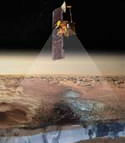
Image credit: NASA
As predicted last week, NASA scientists announced that they have discovered evidence of vast deposits of water ice under the rocky surface of Mars. Special detectors on the Mars Odyssey spacecraft have found strong signals of enough ice to fill up Lake Michigan. As we’ve found on Earth, wherever there’s water and heat, there’s life, so this is encouraging for the search for life on Mars. This is also encouraging for possible future human missions to the Red Planet, as astronauts will have easy access to water for drinking, as well as hydrogen and oxygen.
Using instruments on NASA’s 2001 Mars Odyssey spacecraft, surprised scientists have found enormous quantities of buried treasure lying just under the surface of Mars — enough water ice to fill Lake Michigan twice over. And that may just be the tip of the iceberg.
Images are available at http://www.jpl.nasa.gov/images/mars and http://mars.jpl.nasa.gov/odyssey.
“This is really amazing. This is the best direct evidence we have of subsurface water ice on Mars. We were hopeful that we could find evidence of ice, but what we have found is much more ice than we ever expected,” said Dr. William Boynton, principal investigator for Odyssey’s gamma ray spectrometer suite at the University of Arizona, Tucson.
Scientists used Odyssey’s gamma ray spectrometer instrument suite to detect hydrogen, which indicated the presence of water ice in the upper meter (three feet) of soil in a large region surrounding the planet’s south pole. “It may be better to characterize this layer as dirty ice rather than as dirt containing ice,” added Boynton. The detection of hydrogen is based both on the intensity of gamma rays emitted by hydrogen, and by the intensity of neutrons that are affected by hydrogen. The spacecraft’s high-energy neutron detector and the neutron spectrometer observed the neutron intensity.
The amount of hydrogen detected indicates 20 to 50 percent ice by mass in the lower layer. Because rock has a greater density than ice, this amount is more than 50 percent water ice by volume. This means that if one heated a full bucket of this ice-rich polar soil it would result in more than half a bucket of water.
The gamma ray spectrometer suite is unique in that it senses the composition below the surface to a depth as great as one meter. By combining the different type of data from the instrument, the team has concluded the hydrogen is not distributed uniformly over the upper meter but is much more concentrated in a lower layer beneath the top-most surface.
The team also found that the hydrogen-rich regions are located in areas that are known to be very cold and where ice should be stable. This relationship between high hydrogen content with regions of predicted ice stability led the team to conclude that the hydrogen is, in fact, in the form of ice. The ice-rich layer is about 60 centimeters (two feet) beneath the surface at 60 degrees south latitude, and gets to within about 30 centimeters (one foot) of the surface at 75 degrees south latitude.
“Mars has surprised us again. The early results from the gamma ray spectrometer team are better than we ever expected,” said Dr. R. Stephen Saunders, Odyssey’s project scientist at NASA’s Jet Propulsion Laboratory, Pasadena, Calif. “In a few months, as we get into martian summer in the northern hemisphere, it will be exciting to see what lies beneath the cover of carbon dioxide dry-ice as it disappears.”
“The signature of buried hydrogen seen in the south polar area is also seen in the north, but not in the areas close to the pole. This is because the seasonal carbon dioxide (dry ice) frost covers the polar areas in winter. As northern spring approaches, the latest neutron data indicate that the frost is receding, revealing hydrogen-rich soil below,” said Dr. William Feldman, principal investigator for the neutron spectrometer at Los Alamos National Laboratories, New Mexico.
“We have suspected for some time that Mars once had large amounts of water near the surface. The big questions we are trying to answer are, ‘where did all that water go?’ and ‘what are the implications for life?’ Measuring and mapping the icy soils in the polar regions of Mars, as the Odyssey team has done, is an important piece of this puzzle, but we need to continue searching, perhaps much deeper underground, for what happened to the rest of the water we think Mars once had,” said Dr. Jim Garvin, Mars Program Scientist, NASA Headquarters, Washington, D.C.
Another new result from the neutron data is that large areas of Mars at low to middle latitudes contain slightly enhanced amounts of hydrogen, equivalent to several percent water by mass. Interpretation of this finding is ongoing, but the team’s preliminary hypothesis is that this relatively small amount of hydrogen is more likely to be chemically bound to the minerals in the soil, than to be in the form of water ice.
JPL manages the 2001 Mars Odyssey mission for NASA’s Office of Space Science, Washington, D.C. Investigators at Arizona State University, Tempe; the University of Arizona, Tucson; and NASA’s Johnson Space Center, Houston, operate the science instruments. The gamma-ray spectrometer was provided by the University of Arizona in collaboration with the Russian Aviation and Space Agency, which provided the high-energy neutron detector, and the Los Alamos National Laboratories which provided the neutron spectrometer. Lockheed Martin Astronautics, Denver, developed and built the orbiter. Mission operations are conducted jointly from Lockheed Martin and from JPL, a division of the California Institute of Technology in Pasadena.
Additional information about the 2001 Mars Odyssey and the gamma-ray spectrometer is available on the Internet at: http://mars.jpl.nasa.gov/odyssey/ and http://grs.lpl.arizona.edu.
Original Source: NASA/JPL News Release
Microwave View of the Universe’s Oldest Light
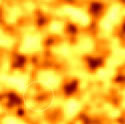
Image credit: NSF
Astronomers from the National Science Foundation and Caltech have created the most detailed images ever made of the oldest light emitted by the Universe. The team used the Cosmic Background Imager, an array of sensitive microwave detectors in the Chilean desert, to gather light that had traveled 14 billion years to reach the Earth; it shows us the Universe at only 300,000 years old, just as seeds of matter had started to form, eventually becoming galaxies, stars, planets, and us.
Astronomers operating from a remote plateau in the Chilean desert have produced the most detailed images ever made of the oldest light emitted by the universe, providing independent confirmation of controversial theories about the origin of matter and energy.
Pushing the limits of available technology, the Cosmic Background Imager (CBI) funded by the National Science Foundation (NSF) and California Institute of Technology (Caltech) detected minute variations in the cosmic microwave background, the radiation that has traveled to Earth over almost 14 billion years. A map of the fluctuations shows the first tentative seeds of matter and energy that would later evolve into clusters of hundreds of galaxies.
The measurements also provide independent evidence for the long-debated theory of inflation, which states that the universe underwent a violent expansion in its first micro-moments. After about 300,000 years it cooled enough to allow the seeds of matter to form and became “transparent,” allowing light to pass through. CBI observed remnants of that early radiation. The data are also helping scientists learn more about the repulsive force called “dark energy” that appears to defy gravity and force the universe to accelerate at an ever-increasing pace.
“This is basic research at its finest and most exciting,” said NSF Director Rita Colwell. “Each new image of the early universe refines our model of how it all began. Just as the universe grows and spreads, humankind’s knowledge of our own origins continues to expand, thanks to the technical expertise and patient persistence of scientists such as these.”
“We have seen, for the first time, the seeds that gave rise to clusters of galaxies, thus putting theories of galaxy formation on a firm observational footing,” said team leader Anthony Readhead of Caltech. “These unique high-resolution observations provide a new set of critical tests of cosmology, and provide new and independent evidence that the universe is flat and is dominated by dark matter and dark energy.”
Readhead, with Caltech colleagues Steve Padin and Timothy Pearson and others from Canada, Chile and the United States, generated the finest measurements to date of the cosmic microwave background. Cosmic microwave background (CMB) is a record of the first photons that escaped from the rapidly cooling, coalescing universe about 300,000 years after the cosmic explosion known as the Big Bang that is commonly believed to have given birth to the universe.
Data from the CBI on temperature distributions in the CMB support a modification of the Big Bang theory; that modification is called inflation theory. Inflation states that the hot plasma of the initial universe underwent an extreme and rapid expansion in its first 10 -32 second. The variations in temperature measured by the CBI are as small as 10 millionths of a degree.
By plotting the peaks of temperature distribution, the scientists showed that the precise CBI data are entirely consistent with inflation and confirm earlier findings by other scientists. In April 2000, an international team of cosmologists led by Caltech’s Andrew Lange announced the first compelling evidence that the universe is flat-that is, its geometry is such that parallel lines will neither converge or diverge. Lange’s team observed at a different frequency from CBI, using a high-altitude balloon flown over Antarctica.
Since then, two other teams — using independent methods — have revealed their analyses of the very faint variations in temperature among the cosmic microwaves. The four instruments have conducted precise measurements of parameters that cosmologists have long used to describe the early universe. Each set of data has offered new clues to the form of the embryonic plasma and has drawn scientists closer to definitive answers. NSF has supported the work of all four teams and their instruments, some of them for more than 15 years.
Five papers on the CBI data were submitted today to the Astrophysical Journal for publication.
The CBI consists of 13 interferometers mounted on a 6-meter-diameter platform, operating at frequencies from 26 GHz to 36 GHz. Located in the driest desert in the world — the Atacama — CBI takes advantage of the low humidity at an altitude of 5,080 meters (16,700 feet). NSF has supported the CBI research since 1995. The National Council of Science and Technology of Chile provided the CBI site.
Original Source: NSF News Release
